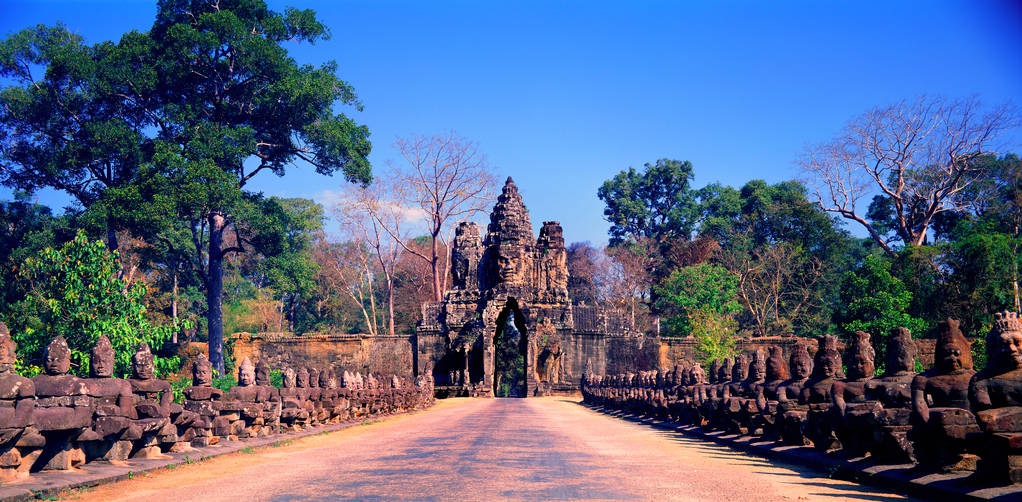At the South Gate of Angkor Thom, you’ll encounter a magnificent 20-meter-high entrance that blends spiritual power with architectural brilliance. Built during Jayavarman VII’s reign in the 12th century, this colossal gateway features four towering faces of Avalokiteshvara watching over you from each cardinal direction. The causeway’s epic “Churning of the Ocean of Milk” scene, with its gods and demons, sets the stage for the ancient wonders that await beyond these sacred walls.
Key Takeaways
- The South Gate serves as the main entrance to Angkor Thom, symbolizing the transition between earthly and divine realms through its monumental architecture.
- Four giant faces of Avalokiteshvara Bodhisattva guard the gate from all directions, representing divine protection and Buddhist compassion.
- The causeway features the “Churning of the Ocean of Milk” myth with gods and demons, demonstrating cosmic balance and spiritual significance.
- Built during King Jayavarman VII’s reign, the gate represents royal power and authority through its massive 20-meter height and engineering precision.
- The gate’s architectural design combines practical defense with religious symbolism, featuring detailed carvings and impressive laterite construction without mortar.
The Historical Legacy of Angkor Thom’s South Gate
A tribute to architectural magnificence, Angkor Thom’s South Gate stands as one of humanity’s most remarkable achievements from the late 12th century.
When you visit this incredible structure, you’ll witness the historical context of King Jayavarman VII‘s vision come to life before your eyes!
The gate’s royal symbolism tells an amazing story of power and divine authority.
You’ll find yourself walking the same causeway where ancient kings once processed, surrounded by stunning mythological scenes depicting the “Churning of the Ocean of Milk.”
What’s really fascinating is how this massive entrance served both practical and spiritual purposes – it’s not just a gate, it’s a gateway to understanding an empire!
From its religious carvings to its perfectly preserved state, the South Gate continues to captivate visitors and scholars alike.
Architectural Marvels and Design Elements
Building upon the South Gate’s rich historical legacy, its architectural brilliance truly showcases the pinnacle of Khmer engineering! Standing at an impressive 20 meters high, you’ll be amazed by the gate’s unique architectural styles that blend form and function.
Rising 20 meters skyward, the South Gate stands as a testament to Khmer engineering mastery, where artistry meets architectural innovation.
The cruciform layout features a central tower with three false levels, while the massive doorway measures 3.5 meters wide and 7 meters high.
You’ll uncover these stunning design features throughout the structure:
- Four giant faces of the Bodhisattva gazing in cardinal directions
- Tri-headed elephants pulling lotus flowers
- Intricate carvings of deities and mythical creatures
- Vaulted side galleries that served as guardhouses
What’s remarkable is how the entire structure was built using laterite blocks fitted side by side without mortar – talk about precision engineering that’s stood the test of time!
The Sacred Path: Mythological Stories Along the Causeway
While strolling along the causeway to Angkor Thom’s South Gate, you’ll be transported into one of Hinduism’s most epic tales – the Churning of the Ocean of Milk!
On either side of you, massive stone statues tell this incredible story through mythological symbolism.
You’re walking between two rows of figures – divine gods on your left and powerful demons on your right – all gripping a massive serpent in an eternal tug-of-war to churn the cosmic ocean.
This dramatic scene represents the perfect cosmic balance between opposing forces, each working together to release the elixir of life.
These larger-than-life 12th-century sculptures aren’t just decorative – they’re your gateway between the mortal world and the divine dimension.
Talk about an epic entrance!
Spiritual Importance in Buddhist Culture
Moving beyond the mythological drama of the causeway, the South Gate reveals its profound Buddhist soul through four towering faces that will stop you in your tracks.
These serene visages represent Avalokiteshvara, the bodhisattva of compassion, watching over you with eternal vigilance.
You’ll uncover how Buddhist symbolism and spiritual guidance merge in this architectural masterpiece, where King Jayavarman VII’s vision comes alive.
The gate serves as your passage from the ordinary world into Angkor Thom’s sacred domain.
Here’s what makes this gateway so spiritually significant:
- Each face gazes in a cardinal direction, offering protection from all angles
- The serene expressions convey divine guidance and benevolence
- Traditional Khmer art blends seamlessly with Buddhist elements
- The massive scale demonstrates both spiritual and royal authority
Planning Your Visit to the South Gate
Ready to investigate the majestic South Gate of Angkor Thom? You’ll find this architectural marvel just 1.7 km from Angkor Wat’s entrance and 7.2 km from Siem Reap.
In terms of transportation options, you’ve got choices – grab a tuk-tuk for the best bang for your buck, or opt for a motorbike, cab, or hotel shuttle.
Don’t skip ticket booking – at $36.07, your pass reveals the entire complex!
Pro tip: book a day ahead and arrive early (the gate opens at 5 a.m.!) to beat the crowds that swarm in between 9-10 a.m.
You’ll want plenty of space to admire those incredible stone faces and the 108 figures along the causeway.
Bring comfortable shoes, water, and sunscreen – there’s so much to investigate, including elephant rides and the nearby Bayon Temple!
Conservation Efforts and Preservation Status
The preservation of Angkor Thom’s South Gate stands as a remarkable demonstration to international cooperation and modern conservation techniques.
Standing centuries old, Angkor Thom’s South Gate exemplifies how global partnerships and modern science unite to safeguard humanity’s treasures.
You’ll be amazed at how UNESCO and Cambodian authorities work together to protect this architectural masterpiece using cutting-edge conservation techniques and careful visitor management strategies.
Here’s what makes the preservation efforts so impressive:
- Advanced monitoring systems track the gate’s structural integrity 24/7
- International experts collaborate with local teams to combat erosion
- Strict visitor management practices protect ancient sandstone carvings
- UNESCO World Heritage status guarantees global support and funding
Since its removal from the World Heritage in Danger list in 2004, you can witness firsthand how successful these conservation efforts have been.
The gate’s remarkable condition today is a proof of the power of international cooperation!
Beyond the Gate: Connected Temples and Monuments
Majestic stone monuments radiate outward from Angkor Thom’s South Gate, creating a mesmerizing network of ancient Khmer architecture that you won’t want to miss. The temple connections showcase the incredible historical significance of this sacred complex, where you’ll uncover hidden gems at every turn!
| Monument | Key Feature |
|---|---|
| Bayon Temple | 216 enigmatic stone faces |
| Royal Palace | Heart of imperial power |
| Elephant Terrace | Royal ceremony platform |
| Baksei Chamkrong | Intimate pyramid temple |
You’ll find these magnificent structures interconnected by ancient pathways, each telling its own fascinating story. The Bayon Temple’s mysterious faces echo those at the South Gate, while the Royal Palace ruins whisper tales of past grandeur. Don’t miss the Elephant Terrace, where Khmer kings once watched elaborate performances – it’s an absolute must-see!
Conclusion
When you visit Angkor Thom’s South Gate today, you’re walking through one of history’s most impressive architectural achievements. It’s not just a gateway – it’s a spiritual bridge between worlds that’s stood for over 800 years! Whether you’re drawn to its imposing faces, intricate demon-and-god carvings, or the ancient spiritual symbolism, this majestic entrance continues to be the perfect starting point for your Angkor adventure.



